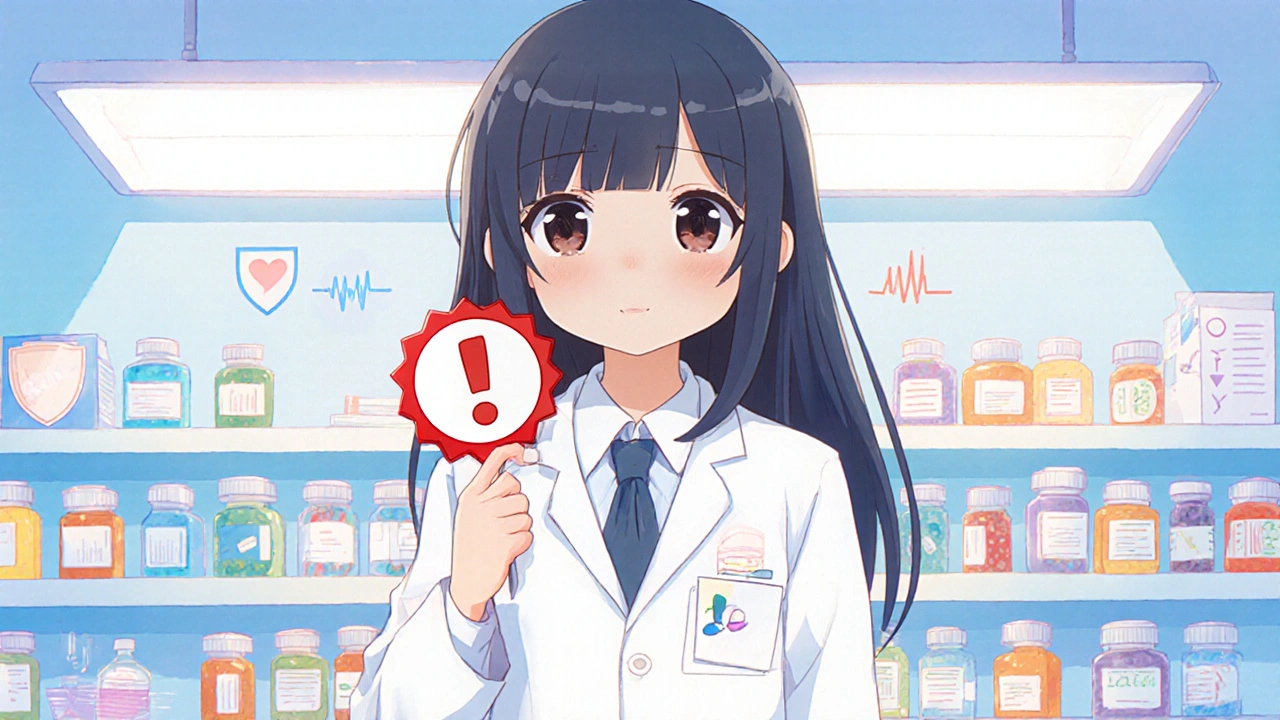How to Track Drug Recalls and Safety Alerts Efficiently
26 Oct, 2025Drug Safety Alert Priority Calculator
Alert Priority Calculator
Determine the priority level of drug safety alerts to manage alert fatigue and ensure critical safety information isn't overlooked.
Drug Recalls are mandatory removals of pharmaceutical products from the market when a serious risk to patients is identified. Drug Safety Alerts are rapid communications that warn clinicians and consumers about emerging safety concerns before a product is pulled.
Key Takeaways
- Three major agencies-FDA, EMA, and Health Canada-run distinct but overlapping alert systems.
- Signing up for email, RSS, or mobile app feeds gives you real‑time notifications.
- Tiered alert strategies and customized EMR filters cut down alert fatigue.
- Regular training and a simple checklist keep you from missing critical updates.
Why Drug Recalls and Safety Alerts Matter
Most adverse events only surface after a drug reaches thousands of patients. The FDA’s 2022 Drug Safety Report shows that its monitoring networks process over 2 million adverse‑event reports each year and prevent an estimated 350 000 serious events. Similar numbers come from the EMA and WHO, which together handle tens of millions of reports. When a safety signal hits a threshold, agencies issue a Drug Safety Communication (DSC) or a comparable alert. Missing these messages can lead to repeat prescriptions of a harmful drug, legal liability, and-worst of all-patient harm.
Who Issues the Alerts? The Main Players
The landscape is dominated by three governmental bodies and a global watchdog:
- FDA (U.S.) - runs MedWatch, the Drug Safety Communications (DSC) service, and the Sentinel Initiative.
- EMA (Europe) - operates EudraVigilance and the Pharmacovigilance Risk Assessment Committee (PRAC).
- Health Canada - uses the Canada Vigilance Program and categorises alerts as Serious, Moderate, or Low.
- World Health Organization - maintains VigiBase, the world’s largest safety database, and offers the VigiMobile app for low‑resource settings.
Each agency has its own terminology and timelines, but they all share a common goal: get actionable information into the hands of prescribers fast.
How the Alert Networks Work
All four systems follow a similar pipeline:
- Report intake - clinicians, patients, or manufacturers submit an adverse‑event report.
- Signal detection - algorithms flag patterns that exceed expected rates.
- Scientific review - experts assess causality, severity, and population impact.
- Communication - a DSC, safety alert, or recall notice is drafted and distributed.
- Follow‑up - label changes, market withdrawals, or further studies are launched.
The FDA processes about 1.3 million reports annually, usually within 15 business days. EMA’s timeline stretches to 30 days, but it provides richer post‑authorization safety studies. Health Canada’s system is faster for local issues, while WHO aggregates global data to spot rare events that may never appear in a single country’s database.
Signing Up for Real‑Time Alerts
Staying informed starts with a subscription. Below are the most reliable ways to get notifications:
- Email lists - The FDA’s DSC list had 457 832 subscribers in Q2 2023. EMA offers a free EudraVigilance email feed; Health Canada provides a weekly safety bulletin.
- RSS feeds - All three agencies publish RSS streams for recall notices and safety communications.
- Mobile apps - The FDA MedWatch app (iOS/Android) logged 187 450 downloads by September 2023. WHO’s VigiMobile is active in 37 countries.
- EMR integration - Many hospitals use commercial tools like Wolters Kluwer’s Medi‑Span to push alerts directly into prescribing screens.
Pick at least two channels-email for daily digests and an app for on‑the‑go checks-to create redundancy.
Comparison of Major Alert Systems
| Agency | Primary Tool | Report Processing Time | Alert Types | Annual Reports Handled |
|---|---|---|---|---|
| FDA (U.S.) | MedWatch / DSC | ≤ 15 business days | DSC, Drug Alerts, Labeling Changes | 1.3 M (2023) |
| EMA (EU) | EudraVigilance / PRAC | ≤ 30 days | Safety Communications, PRAC Recommendations | ≈ 700 k new reports/quarter |
| Health Canada | Canada Vigilance | ≈ 10 days | Serious, Moderate, Low alerts | ~ 150 k (2023) |
| WHO | VigiBase / VigiMobile | Varies (global aggregation) | Global Safety Alerts, Public Advisories | 35 M cumulative cases |
The table shows that the FDA wins on speed, EMA excels in detailed safety studies, and WHO provides the broadest international coverage. Your choice of feed should match the geography of your practice and the therapeutic areas you cover.
Embedding Alerts into Your Clinical Workflow
Even if you receive every alert, you’ll quickly drown in noise. Studies show clinicians see an average of 67 drug‑safety alerts each week, yet only 12 % are truly urgent. The solution is a tiered system:
- Critical - Must be acted on within 1 hour (e.g., a recall of a contaminated batch).
- Important - Review within 24 hours (e.g., new boxed‑warning for a class of drugs).
- Informational - Archive for reference (e.g., updates on ongoing post‑marketing studies).
Kaiser Permanente’s EMR customisation cut alert overrides from 91 % to 37 % by applying exactly this approach. Most commercial alert platforms let you map the agency’s alert type to your internal severity levels, so you can automate routing to the right team.

Common Pitfalls and How to Avoid Them
Alert fatigue is the #1 barrier. Here’s how to keep it from crippling your practice:
- Don’t subscribe to every list. Focus on the drug classes you prescribe most.
- Use keyword filters. Set up rules that only pass alerts mentioning “recall,” “boxed warning,” or the specific generic name.
- Validate before acting. Cross‑check a DSC with the FDA’s official recall page; most agencies host a PDF with the full rationale.
- Train staff regularly. A 3‑hour MedWatch workshop reduces reporting errors by 27 % (ECRI, 2022).
When you combine smart filtering with routine training, you’ll see a noticeable drop in ignored alerts and an increase in patient safety outcomes.
Practical Checklist to Stay Informed
- Identify the agencies that regulate the drugs you use most.
- Subscribe to at least two delivery methods (email + app).
- Configure your EMR or pharmacy system with a three‑tier alert hierarchy.
- Schedule quarterly training refreshers for the whole prescribing team.
- Test the workflow with a simulated recall (e.g., a mock FDA DSC for a non‑critical drug).
- Document the process in your SOP library and review annually.
Follow this list, and you’ll be able to act on a safety alert the same day it’s published-exactly what the regulators expect you to do.
Future Trends You Should Watch
Pharmacovigilance is getting a high‑tech makeover. The FDA’s AI‑driven Sentinel System now scans 1.2 billion patient records and flags signals 40 % faster than before. EMA is rolling out machine‑learning models that pre‑screen 42 % of new signals. WHO’s expansion of VigiFlow will bring 45 new countries into the global network, improving coverage for rare adverse events. Keep an eye on social‑media monitoring pilots-by 2026, many agencies plan to sift through millions of health‑related posts daily to catch early warnings.
How can I receive FDA drug recall alerts on my phone?
Download the FDA MedWatch app from the Apple App Store or Google Play. After creating a free account, enable push notifications for "Drug Safety Communications" and "Recalls." The app also lets you file adverse‑event reports directly.
Do I need to monitor all three agencies (FDA, EMA, Health Canada) if I practice in the United States?
For U.S. patients, the FDA is the primary source. However, many drugs are manufactured abroad; EMA and Health Canada alerts can surface issues before the FDA issues a DSC. Subscribing to EMA’s RSS feed for your key drug classes adds an extra safety net at minimal cost.
What’s the difference between a Drug Safety Communication and a recall?
A DSC warns about a newly identified risk but the product stays on the market, often with updated labeling. A recall means the product must be removed or returned because the risk outweighs any benefit.
Can patients report adverse events themselves?
Yes. The FDA MedWatch portal has a consumer‑friendly form. In 2022, more than 21 000 consumer reports were filed, 67 % via mobile devices.
How often should my practice review its alert‑handling SOP?
At least once a year, or whenever a major regulatory change occurs (e.g., new AI‑based signal detection tools).

Miracle Zona Ikhlas
October 26, 2025 AT 20:53Set up keyword filters in your EMR so only recalls and boxed‑warnings for the drugs you actually prescribe push through; that alone can shave hours off daily inbox clutter.
naoki doe
October 26, 2025 AT 23:20Honestly, if you don’t already have a two‑step verification for alert subscriptions you’re just inviting spam into the system.
Samantha Taylor
October 27, 2025 AT 03:04While the guide eloquently lists the major agencies, it neglects to mention that most clinicians still rely on third‑party aggregators like MyMedWatch, which often repackage FDA DSCs with proprietary latency metrics.
Joe Langner
October 27, 2025 AT 10:26First off, congrats on getting a solid baseline workflow; the real challenge is keeping it sustainable when the alert volume spikes.
You’ll want to segment alerts into three buckets: critical, important, and informational, as the article suggests, but also assign a clear owner for each category.
For critical alerts, the on‑call pharmacist should receive a push notification that requires acknowledgment within an hour.
Important alerts can be routed to the clinical team’s daily briefing, where they’re discussed briefly before the day’s rounds.
Informational alerts are best logged in a shared drive for future reference – no need to clutter the inbox.
Don’t forget to set up automatic escalation rules in your EMR so that a missed critical alert triggers a secondary alert to a senior clinician.
Regular drills, like a mock recall of a non‑essential medication, help the team stay sharp and reveal hidden gaps.
You should also incorporate a “quiet time” window where only critical alerts break through, reducing burnout during night shifts.
Keep your keyword filters dynamic; what’s high‑priority today might be low‑priority next quarter as formularies change.
Encourage junior staff to flag any false‑positive alerts they encounter – that feedback loop improves the algorithm over time.
Document every change to the alert configuration in a version‑controlled SOP repository.
Periodic reviews, at least quarterly, ensure that your hierarchy remains aligned with evolving prescribing patterns.
Leverage analytics from your alert platform to spot trends, such as a surge in dermatology‑related warnings that might indicate a batch issue.
Celebrate successes publicly, like when your team caught a recall within minutes; it reinforces the importance of the system.
Finally, remember that technology is only as good as the people behind it – keep training and morale high, and the alerts will serve their purpose without turning into noise.
Ben Dover
October 28, 2025 AT 00:20It is evident that the proliferation of alert channels, while well‑intentioned, suffers from diminishing returns when the signal‑to‑noise ratio is not meticulously curated by the institution’s pharmacovigilance committee.
Katherine Brown
October 28, 2025 AT 05:53Consequently, I would recommend a periodic audit of subscription lists, ensuring alignment with the therapeutic domains most pertinent to your practice’s patient demographics.
Tony Stolfa
October 28, 2025 AT 14:13Listen, if you’re still manually scanning RSS feeds on a weekend you’re basically living in the Stone Age – automate or get left behind.
Ramesh Kumar
October 29, 2025 AT 04:06In addition to the FDA MedWatch app, the Indian CDSCO also offers a mobile portal that pushes recall notices for medicines marketed domestically, which can be handy for diaspora practitioners.
Barna Buxbaum
October 29, 2025 AT 09:40That’s a solid tip – I’ve also found the WHO VigiMobile notifications to be surprisingly timely for generic products.